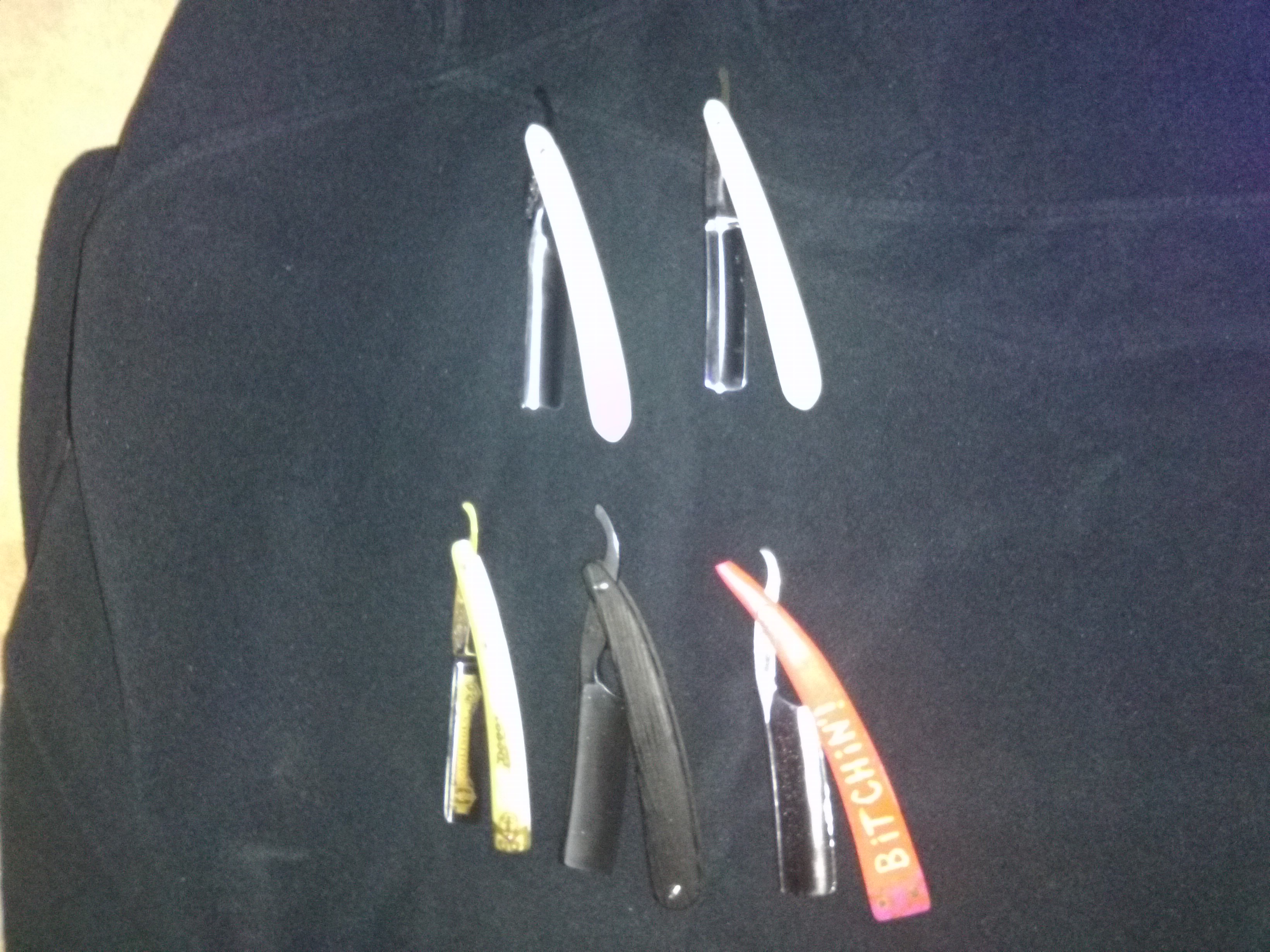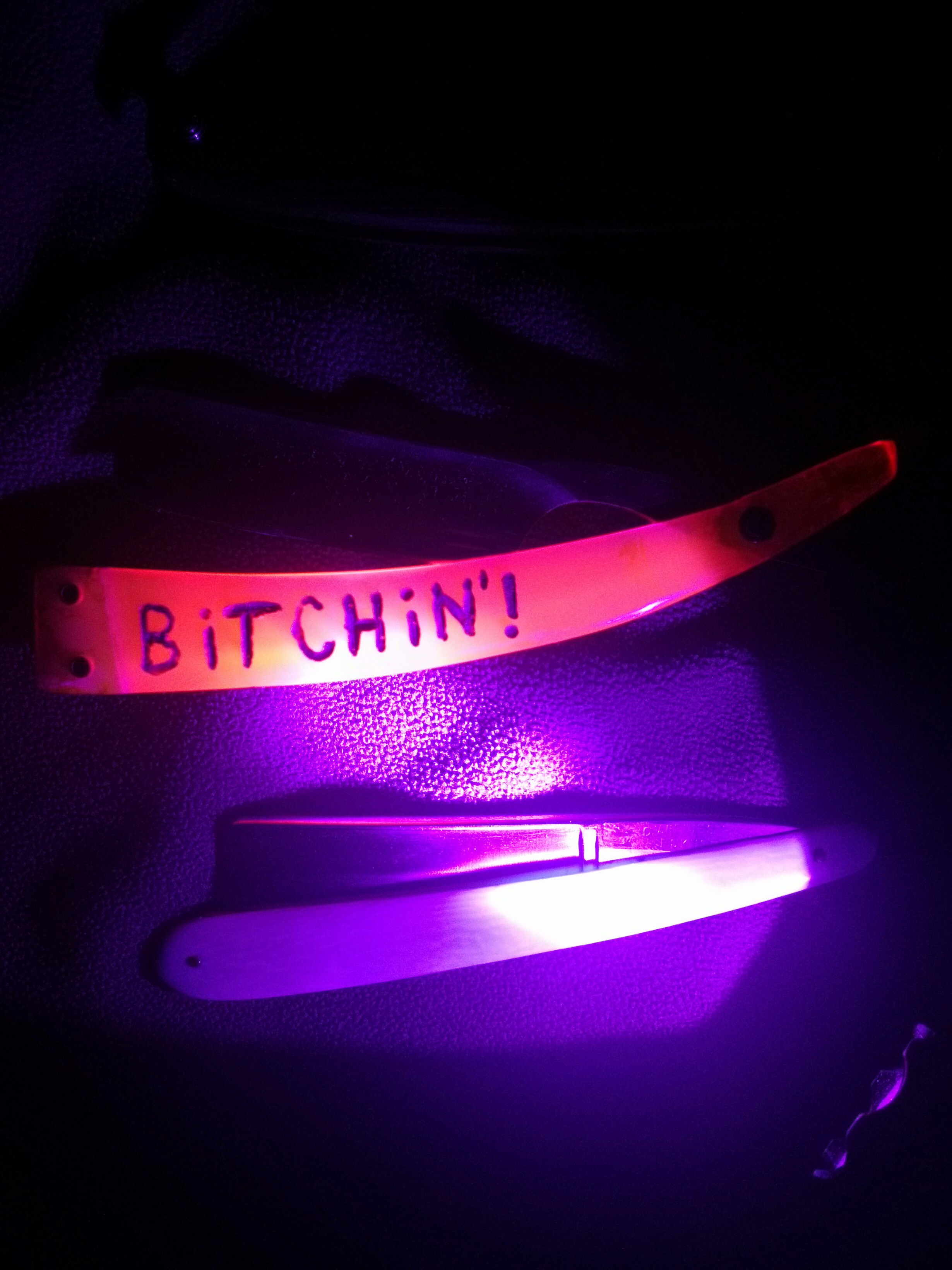Results 31 to 40 of 45
-
09-05-2015, 10:58 PM #31

I found this thread very interesting so I thought that I'd post so I can hopefully see the black light results. I'm never too old to learn something new.

By the way those are really nice looking scales/I would never have guessed them to be camel bone! Our house is as Neil left it- an Aladdins cave of 'stuff'.
Our house is as Neil left it- an Aladdins cave of 'stuff'.
Kim X
-
09-05-2015, 11:18 PM #32

No 'trickery' involved here! I would think the camel bone scales shown are heavily-oiled which changes the appearance. They appear to be yellowed, soft, and resembling translucent horn, while the collars and escutcheon give them away to have been recently-made or possibly restored.
I have several sets of old bone/ivory scales which have been over-oiled and the appearance is the same. Camel bone scales without oil have no such appearance. JMO
I do , however, like the result!
Last edited by sharptonn; 09-06-2015 at 01:11 AM.
"Don't be stubborn. You are missing out."
I rest my case.
-
09-06-2015, 09:06 AM #33< Banned User >

- Join Date
- Dec 2013
- Location
- Perth, Western Australia
- Posts
- 318
Thanked: 44
Dead on Tom! I finished them with 3000# wet and dry and then saturated them with grape seed oil in a vacuum chamber. They're about two or three years old now and over time they have yellowed more and more. The escutcheons (I just learnt a new word), one each side, I filed out of a brass key. I'll be interested to see the results of the black light idea if anyone has the equipment and time to post it. Sounds like it might be a good non-destructive way of determining material for those of us who struggle otherwise.
Regards,
Dave
-
The Following User Says Thank You to puketui41 For This Useful Post:
sharptonn (09-06-2015)
-
09-06-2015, 03:20 PM #34

Good thinking on the vacuum chamber. The one's I have which are over-oiled resulted from someone slathering the blade with too much oil and it soaking in, making splotches. I have not been able to get the oil out, nor making them uniform with more oil.
Someday I will rig up a vacuum chamber (lots of examples in the workshop) and give it a go. .
I recognize the cat's eye collars from Babur. He has sent me several different escutcheons with tiny pins as gifts on larger orders. His pins are great for many razors.
I just assumed it was from him as well. There are many, many threads here on identifying ivory, bone, etc with some great pictures/examples. All one must do is a forum search on the subject."Don't be stubborn. You are missing out."
I rest my case.
-
09-06-2015, 09:18 PM #35

If you try and use UV radiation keep in mind many razor scales have been treated with a variety of substances not to mention cleaners, waxes or oils or even dirt and dust which fluoresce on their own so for the test to be true you need a raw sample of the substance for it to be valid.
No matter how many men you kill you can't kill your successor-Emperor Nero
-
09-06-2015, 09:45 PM #36

Well, full disclosure, I'm part of one of Germany's most successful geocaching owner groups. We specialise in abandoned military installations, so our UV lamps are a bit on the bright side. I tried four of them, and, well, photographing the results wasn't fun. The results are, mildly put, poor. But I can assure you that if you hit ivory with a UV lamp, nothing happens. Well, the ivory develops a light greenish yellow shine, but that's that. If you see ivory, you'll know it's ivory, trust me. Bone is a completely different material. For good measure, I took pictures of ivory, celluloid, wood, and errrr... whatever that pink stuff is. I took the lamp with the highest amount of white light in order to be able to take any pictures, but even the "pure" UV lights didn't return any repeatable effects, ie this test is useless.


-
-
09-06-2015, 10:00 PM #37

That is one bitchin' razor there, Robin! It certainly stands out under the light!
 "Don't be stubborn. You are missing out."
"Don't be stubborn. You are missing out."
I rest my case.
-
09-06-2015, 10:04 PM #38
-
09-06-2015, 10:09 PM #39

I do seem to see some groovy shreger lines on the one under it in the second pic. Perhaps if you angled the light across it?
"Don't be stubborn. You are missing out."
I rest my case.
-
09-06-2015, 10:12 PM #40

The Schreger lines are visible in daylight, too. As I said, I cannot see that UV light adds any visual clues. And, yes, I just did a 720° inspection. The wife is already starting to look concerned.


 69Likes
69Likes LinkBack URL
LinkBack URL About LinkBacks
About LinkBacks








 Reply With Quote
Reply With Quote

